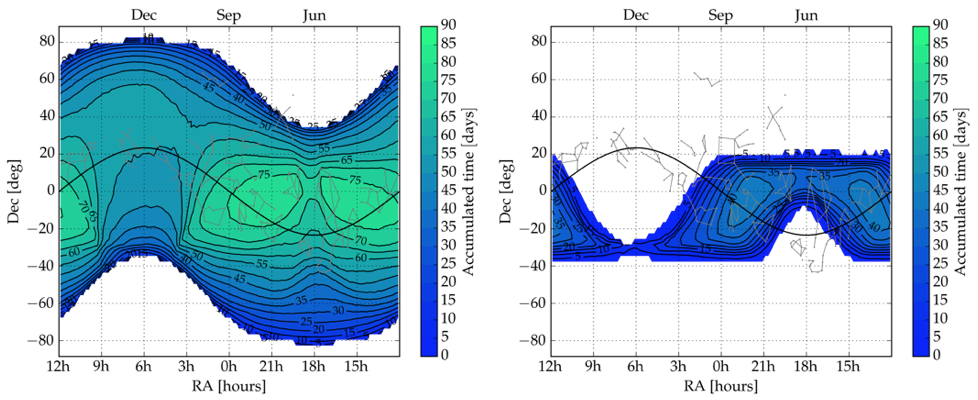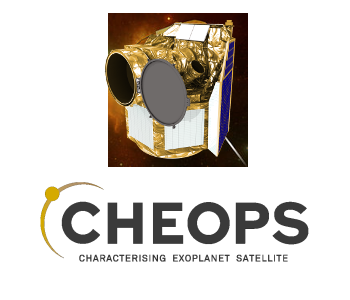CHaracterising ExOPlanet Satellite
(CHEOPS)
Mission Overview:
The CHEOPS mission - adopted by ESA on February 2014 - will be the first S-Class ESA Mission in
partnership with Switzerland and with a number of contributing member states in the CHEOPS Consortium.
It will be the first mission entirely dedicated to search for exoplanets transits through ultra-high
precision photometry of stars already known to host planets.
The satellite was launched on December 18, 2019, for 3.5 years of nominal operations lifetime which on 2023 have been extended to all 2026.
The main scientific objective is the study of the structure of exoplanets smaller than Saturn, orbiting
bright stars. The current ground-based high-precision spectroscopic surveys have determined hundreds
of stars hosting planets with masses in the range of 1 < Mplanet/MEarth < 20, i.e.
from Super-Earth to Neptunes. Planned future ground surveys will continue to increase this sample.
CHEOPS studies of planets' transits of a sample of about 500 targets, with a photometric precision of 20 ppm for a G5 star in 6 hours of integration, will allow to measure radii with a precision of 10% for Neptune
sized planets and so to estimate the bulk planet densities.
The Italian contribution includes the provision of the CHEOPS Telescope, the Science Archive mirror
at the ASI Space Science Data Center, the contribution to the preparation and fulfillment of the CHEOPS science program.
The CHEOPS telescope is a very fast instrument whose design is driven by the requirement of very high
precision and stable photometry, that can be reached by strongly suppress and control the straylight.
Of CHEOPS nominal science observing time (until September 2023), a 20% was available to the scientific community, while on the extended lifetime (until 2026) a 30%, for exoplanets studies through an ESA Guest Observer's (GO) Programme. Annual Announcements of Opportunity (AO) are solicited.
The first AO, AO-1, closed on May 16 2019 and on July 24 12 proposals were awarded with observing time. The second and third AO, AO-2 and AO-3, were closed on December 2020 and March 2022, while the AO-4 closed on May 2023. All the approved AO source lists are available at the ESA sites reported below.
The primary reference for CHEOPS are CHEOPS Definition Study Report (Red Book) and the CHEOPS Observers' Manual (see last AO website).
A full description of the mission can be found at the following links:

On the left: the light curve of the transit of the Jupiter-sized exoplanet WASP-189 b behind its host star HD 133112. Blue points are the CHEOPS flux measures at the maximum time resolution, while black ones are the 10 min binned data. On the right: the light curve of the planet transit in front of the star, where blue points are flux measures at full time resolution, orange line is the best transit model accounting for a deformed star shape, and green for a spherical shaped star (Images: ESA). The ESA news is accessible clicking on the image.

Sky visibility maps from 1 year of simulated CHEOPS data. The least constrained case on the left, with higher levels of stray light, well suited for bright stars; the more constrained case on the right, with lower stray light levels for faint stars observations. Higher percentages of orbit interruptions are shown with lighter green contours (Image: ESA).
SSDC Contribution:
On April 2014 SSDC has been adopted as a SOC partner to host an official CHEOPS Science Archive mirror, with the responsability to keep the archive updated and provide access for scientific users to public and private data. The mirror archive is accessible at the address: https://cheops-archive.ssdc.asi.it/archive_browser/
Moreover, SSDC will support the italian scientific community interested in the CHEOPS mission data.
|
CHEOPS
CHaracterising ExOPlanet Satellite
|
|
Primary goal |
Characterise transiting exoplanets orbiting bright host stars |
|
Targets |
Known exoplanet host stars with a V-magnitude < 12.5 anywhere in the sky |
|
Wavelength |
0.4 to 1.1 µm |
|
Orbit |
Sun-synchronous, 650-800 km altitude, local time of ascending node: 06:00 |
|
Lifetime |
3.5 years |
|
Type |
S-class mission |
|
|



